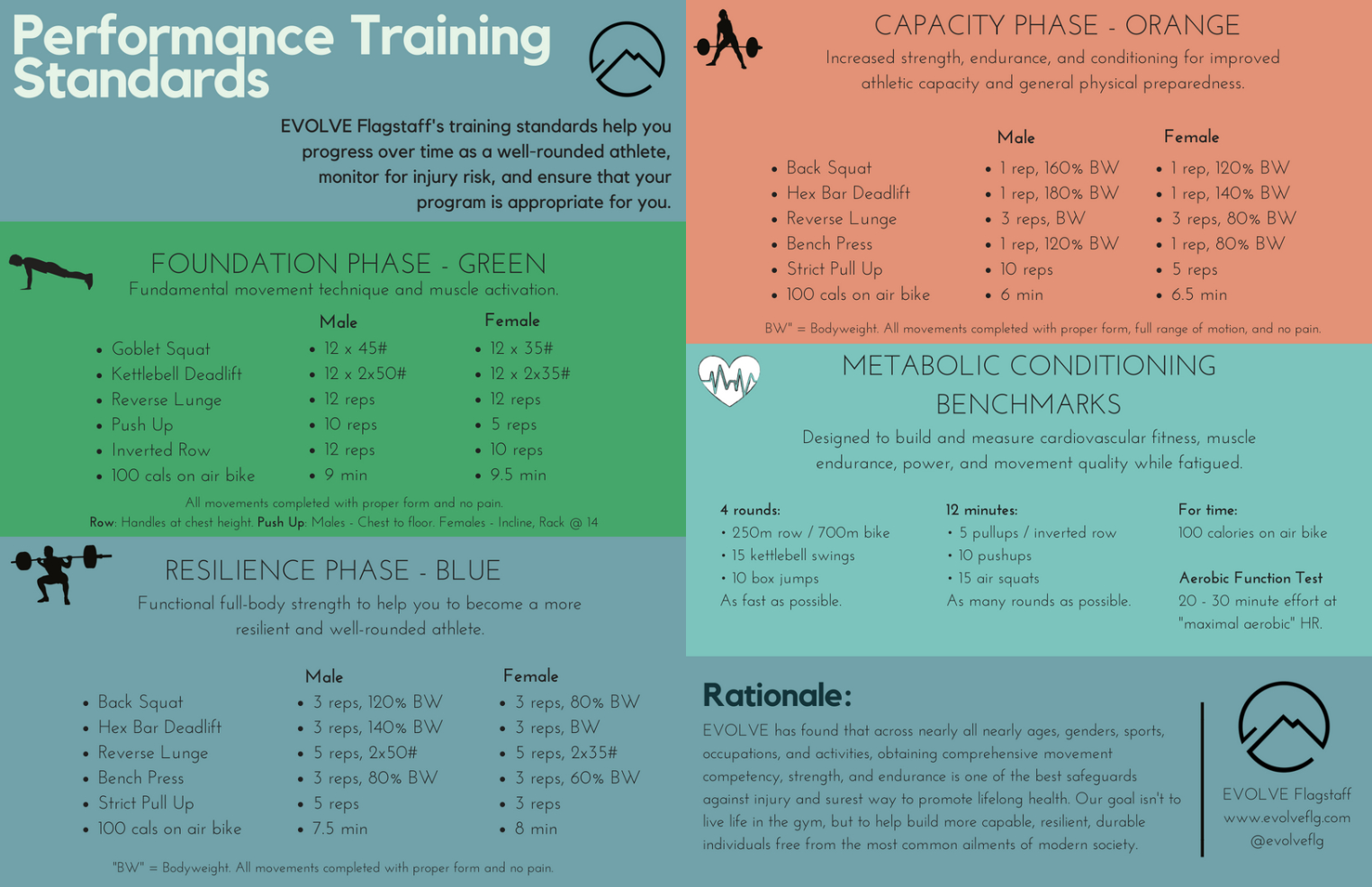Performance Training Standards: How we progress our athletes over time
Central to our Performance Training Program and thought process is progression: How to we make sure that you get from A to B? How to we develop an athlete over time to ensure that they are well-rounded, resilient, durable, and capable?
It's a tricky question, and many people experience problems from a lack of proper progression. These can include:
- Improvements early in a program followed by a plateau.
- Getting injured soon after started a program.
- Excelling in one specific area or domain with little carryover or ability in others.
- Fizzling out of a program because you didn't see "where it was going."
While we want to encourage exercise and physical activity in all of its shapes and forms -- our healthcare system would have much fewer issues if more people were more active in general -- at EVOLVE, we want to be more nuanced, and not simply exercise for the sake of exercise. A training program has a progression model in mind. It's easy to write a hard workout, but more challenging to adequately and appropriately challenge an athlete over time.
So, enter EVOLVE's Performance Training Standards. We have found that across nearly all ages, genders, sports, occupations, and activities, obtaining comprehensive movement competency, strength, and endurance is one of the safeguards against injury and surest way to promote lifelong health. To facilitate this goal, we developed, based on clinical experience and peer-reviewed literature, several training "phases" that progress the athlete from introductory to advanced. We call these our "standards" because we believe that all athletes should develop functional strength and endurance in foundational movement patterns, and that this should be measurable in some way. While every test is necessarily limited, collectively these standards help us get a multidimensional picture of each athlete.
These are detailed in the infographic, but let's also break down some concepts in more detail here:
Movement Competency: We balance consistency with variety here at EVOLVE. We need variety so that training stays interesting and carries over to activities outside the gym. But we also know that to learn a skill, you need practice, and movement is a skill. So, our benchmark standards are centered around a set of fundamental human movement patterns:
- Squat movement
- Hip hinge movement
- Unilateral movement
- Upper body pushes
- Upper body pulls
We frequently return to these fundamental movement patterns, as improving the way that we move is a powerful way to improve performance, reduce pain, and minimize the risk of injury. It's difficult to do that if our core set of movements changes each training session.
Strength: Improving strength is one of the most powerful ways that an individual can improve their health and performance. Improved strength is associated with an increased metabolic rate, improved cardiovascular (running/biking/walking) economy, better insulin sensitivity, improved body composition, improved cardiovascular health, and decreased risk of both acute and overuse sport injuries. Leg strength is associated with lower all cause mortality as well -- there is less risk of dying by any cause if you are stronger. Your body is simply more resilient to stresses placed upon it when you are stronger. There is little if any downside to getting stronger. So, the majority of our standards are centered around getting stronger in our fundamental movement patterns.
Endurance: To balance strength, muscular and cardiovascular endurance is also vital to overall health and wellness. If our endurance is better, we can move longer, faster, and with less fatigue or injury risk. Cardiovascular endurance is also linked to countless health benefits and a longer lifespan (decreased risk of cardiovascular disease, most cancers, obesity, diabetes, and so much more).
Metabolic Conditioning Benchmarks: In addition to our standards for each phase of training, we also have several "benchmarks" that we test with our athletes. These are termed "metabolic conditioning" as they each test a different element of our body's energy systems. Collectively, these test the athlete's ability to generate and absorb force with the posterior chain, maintain position and technique while fatigued, manage bodyweight movements, and sustain both high and lower intensity efforts. We label these "benchmarks" rather than "standards" as the results on these tests will be individual. There's not necessarily "good" or "bad;" rather, we just want to see them improve over time. [Quick side note: The method we are currently using for measuring aerobic function is outlined here. We will write a more detailed post on this in the future.]
When an athlete comes in, they almost always start in our Foundation Phase. The Foundation Phase is focused on improving movement competency, and building a base level of strength, endurance, control, and conditioning. We can also address any injury risk factors or current injuries. Once the athlete meets the Foundation Phase standards, we can then progress their program to the Resilience Phase. This introduces barbell movements that allow for the application of increased loads to our fundamental movement patterns. Technique remains priority throughout, but we can not be more confident that they will handle the increased training load well as we've build their Foundation. The Resilience Phase typically runs for 12 - 16 weeks at a minimum, after which we can move into more advanced programming in the Capacity Phase. In each phase, the movements become more varied and the programming more complex to meet the needs of the athlete. We don't limit ourselves to just the movements outlined in the Standards, but rather use these as a guide to help us develop in a well-rounded fashion.
We will be putting out more details about each phase, standard, and benchmark in future posts. For now, let's get to work training!

